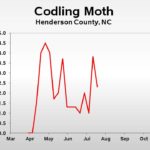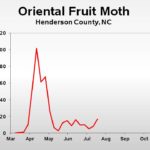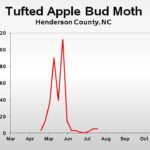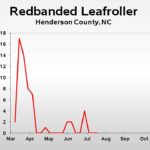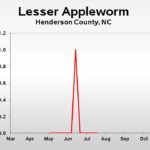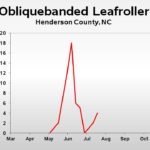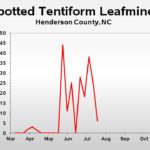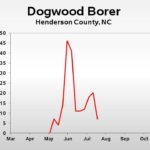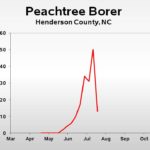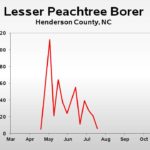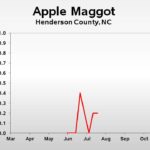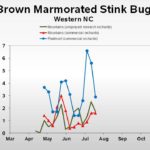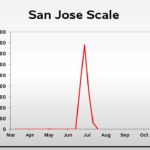WNC Orchard Insect Pest Populations – July 23, 2019
go.ncsu.edu/readext?613328
en Español / em Português
El inglés es el idioma de control de esta página. En la medida en que haya algún conflicto entre la traducción al inglés y la traducción, el inglés prevalece.
Al hacer clic en el enlace de traducción se activa un servicio de traducción gratuito para convertir la página al español. Al igual que con cualquier traducción por Internet, la conversión no es sensible al contexto y puede que no traduzca el texto en su significado original. NC State Extension no garantiza la exactitud del texto traducido. Por favor, tenga en cuenta que algunas aplicaciones y/o servicios pueden no funcionar como se espera cuando se traducen.
Português
Inglês é o idioma de controle desta página. Na medida que haja algum conflito entre o texto original em Inglês e a tradução, o Inglês prevalece.
Ao clicar no link de tradução, um serviço gratuito de tradução será ativado para converter a página para o Português. Como em qualquer tradução pela internet, a conversão não é sensivel ao contexto e pode não ocorrer a tradução para o significado orginal. O serviço de Extensão da Carolina do Norte (NC State Extension) não garante a exatidão do texto traduzido. Por favor, observe que algumas funções ou serviços podem não funcionar como esperado após a tradução.
English
English is the controlling language of this page. To the extent there is any conflict between the English text and the translation, English controls.
Clicking on the translation link activates a free translation service to convert the page to Spanish. As with any Internet translation, the conversion is not context-sensitive and may not translate the text to its original meaning. NC State Extension does not guarantee the accuracy of the translated text. Please note that some applications and/or services may not function as expected when translated.
Collapse ▲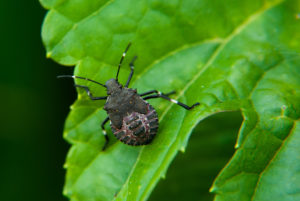 Overall, insect pressure is fairly low throughout the region. Codling moth and oriental fruit moth populations are very low, and first generation brown marmorated stink bug adults are active only in piedmont regions, not yet in the mountains. Also, there has been no evidence of a large emergence of apple maggot as of yet.
Overall, insect pressure is fairly low throughout the region. Codling moth and oriental fruit moth populations are very low, and first generation brown marmorated stink bug adults are active only in piedmont regions, not yet in the mountains. Also, there has been no evidence of a large emergence of apple maggot as of yet.
Second generation codling moth flight is completed in lower elevation piedmont orchards, and is nearly complete in mountain production areas (≥2000 ft elevation). Degree-day accumulations in Henderson County are about 1900 as of July 22, which coincides with emergence of about 90% of second generation adults. This information, combined with very low pheromone trap captures, suggests that the potential for damage is extremely low.
Third generation oriental fruit moth adults are beginning to emerge in mountain locations, but populations generally have been low to date. Pheromone trap captures provide valuable information on the activity of this pest in individual orchards, because population density can be highly variable even among nearby orchards.
First generation brown marmorated stink bug began emergence a little over two weeks ago, and this will continue for a few more weeks. While population densities can vary considerably among locations, this is a potentially critical time for damage in piedmont locaitons.
In the higher elevation mountain counties, first generation BMSB emergence should be in the very early stages, but to date pheromone trap captures have not yet detected this emergence. The main egg laying period for the overwintering generation of BMSB adults began in early June, so based on degree-day accumulations I anticipate a large uptick in trap captures in another 7 to 10 days.
Learn more about southeastern apple insect pests at the Apple Insect Management page.
2019 Average Weekly Trap Captures
| HENDERSON COUNTY | |||
| Insects per trap | |||
| Jul 8 |
Jul 15 |
Jul 23 |
|
| Codling Moth | 1.0 | 3.8 | 2.3 |
| Oriental Fruit Moth | 5.0 | 7.8 | 16.5 |
| Tufted Apple Bud Moth | 2.0 | 5.0 | 5.0 |
| Redbanded Leafroller | 0.0 | 0.0 | 0.0 |
| Obliquebanded Leafroller | 1.0 | 2.0 | 4.0 |
| Lesser Appleworm | 0.0 | 0.0 | 0.0 |
| Apple Maggot (abandoned and research) | 0.0 | 0.2 | 0.2 |
| Brown Marmorated Stink Bug (commercial – mountains) | 0.9 | 1.6 | 1.6 |
| Brown Marmorated Stink Bug (commercial – upper Piedmont) | 6.6 | 5.6 | 2.9 |
| Brown Marmorated Stink Bug (research – unsprayed) | 1.3 | 2.5 | 1.7 |
| Spotted Tentiform Leafminer | 38.0 | 25.0 | 6.0 |
| Dogwood Borer | 18.0 | 20.0 | 7.0 |
| Peachtree Borer | 31.0 | 50.0 | 13.0 |
| Lesser Peachtree Borer | 27.0 | 21.0 | 6.0 |
| San Jose Scale | 330.0 | 57.5.0 | 7.5 |
*Note that these averages illustrate only the timing of insect emergence and fluctuations in populations, and are not representative of population levels in any given orchard. The only way to have an accurate assessment of an individual orchard’s populations is to set up traps in that orchard.
2019 Accumulated Degree Days
| Henderson County | ||||
| Biofix | Jul 8 |
Jul 15 |
Jul 23 |
|
| Codling Moth | Apr 15 | 1499 | 1750 | 1897 |
| Oriental Fruit Moth | Mar 16 | 2169 | 2465 | 2642 |
| Tufted Apple Bud Moth | Apr 20 | 1827 | 2122 | 2299 |
2019 Pest Trends (click to enlarge)
PREVIOUS UPDATES
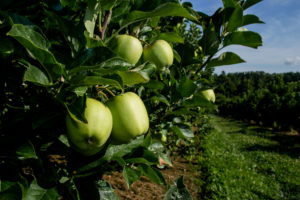 July 15, 2019
July 15, 2019
Codling Moth: In Henderson County and other locations ≥2000 ft elevation, codling moth DD accumulations are about 1700, which coincides with emergence of about 75% of second-generation adults and 35% egg hatch. For those not using mating disruption and who are not using pheromone traps to monitor coding moth, this is an important time for insecticidal control. In orchards monitoring for codling moth and where trap captures have remained low throughout this period, only one insecticide application targeting the second generation is necessary. Insecticides targeting codling moth in orchards using mating disruption are only necessary if pheromone trap captures indicate they are needed – a threshold of an average cumulative trap capture of 3 moths over a two to three week period has worked well to minimize insecticide applications without risk of injury.
In lower elevation orchards (<1000 ft evelation), second-generation codling moth flight is nearly complete. Degree-day accumulations are 2150, which coincides with >95% adult emergence and completion of almost 80% egg hatch. The need for additional insecticide sprays targeting codling moth in these orchards is very low, especially in orchards that have not yet seen damage up to this point in time.
Brown Marmorated Stink Bug: At lower elevation orchards in the piedmont, emergence of first-generation adult pheromone trap captures remains high, and this is an important time for insecticidal control of BMSB.
In mountain locations, first-generation adult emergence has not yet begun. A total of about 495 DD have accumulated since initial egg hatch in mid-May, and adult emergence is not expected to begin until about 540 DD, which will likely occur next weekend. We will continue to follow pheromone trap captures to detect first-generation emergence, but it currently appears that will be when insecticidal control may be necessary.
Other Potential Pest: There have been a few reports of woolly apple aphid infestations. Control of WAA within season is very difficult, with Diazinon 50WP being about the only product that provides reliable knockdown of this pest. However, only the 50W formulation is registered on apples, and it has a 21 day preharvest interval (PHI) and a 4-day re-entry interval (REI). In many situations the parasite Aphelinus mali reduces mid to late-season populations more quickly than insecticides. Parasitized aphids can be recognized by their black opposed to reddish color.
Apple maggot populations remain low at all monitoring sites this week.
Learn more about southeastern apple insect pests at the Apple Insect Management page.
2019 Average Weekly Trap Captures
| HENDERSON COUNTY | |||
| Insects per trap | |||
| Jul 1 |
Jul 8 |
Jul 15 |
|
| Codling Moth | 2.0 | 1.0 | 3.8 |
| Oriental Fruit Moth | 10.0 | 5.0 | 7.8 |
| Tufted Apple Bud Moth | 0.0 | 2.0 | 5.0 |
| Redbanded Leafroller | 4.0 | 0.0 | 0.0 |
| Obliquebanded Leafroller | 0.0 | 1.0 | 2.0 |
| Lesser Appleworm | 0.0 | 0.0 | 0.0 |
| Apple Maggot (abandoned and research) | 0.2 | 0.0 | 0.2 |
| Brown Marmorated Stink Bug (commercial – mountains) | 0.6 | 0.9 | 1.6 |
| Brown Marmorated Stink Bug (commercial – upper Piedmont) | 2.6 | 6.6 | 5.6 |
| Brown Marmorated Stink Bug (research – unsprayed) | 0.7 | 1.3 | 2.5 |
| Spotted Tentiform Leafminer | 18.0 | 38.0 | 25.0 |
| Dogwood Borer | 12.0 | 18.0 | 20.0 |
| Peachtree Borer | 34.0 | 31.0 | 50.0 |
| Lesser Peachtree Borer | 39.0 | 27.0 | 21.0 |
| San Jose Scale | 781.0 | 330.0 | 57.5 |
*Note that these averages illustrate only the timing of insect emergence and fluctuations in populations, and are not representative of population levels in any given orchard. The only way to have an accurate assessment of an individual orchard’s populations is to set up traps in that orchard.
2019 Accumulated Degree Days
| Henderson County | ||||
| Biofix | Jul 1 |
Jul 8 |
Jul 15 |
|
| Codling Moth | Apr 15 | 1344 | 1499 | 1750 |
| Oriental Fruit Moth | Mar 16 | 1983 | 2169 | 2465 |
| Tufted Apple Bud Moth | Apr 20 | 1641 | 1827 | 2122 |
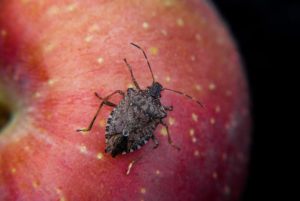 July 9, 2019
July 9, 2019
Codling moth and brown marmorated stink bug remain the insects of concern at this time, with codling moth of greater concern at higher elevations (>2000 ft) and BMSB of greater concern at lower elevations in the piedmont.
Codling Moth: In elevations >2000 ft (e.g., Henderson County) codling moth degree-day accumulations are about 1500, which coincides with about 15% egg hatch of the second generation. This generation will remain a potential threat for possibly two more weeks, although overall populations have been very low.
In Cleveland County (elevation of about 840 ft), codling moth DD accumulations average about 1920, which coincides with 68% egg hatch of the second generation. Second generation flight is predicted to be complete in another 10 days or so.
Brown Marmorated Stink Bug: In Cleveland County, a total of 610 BMSB DD have accumulated since the first egg hatch in early May. Second generation adults were predicted to begin emerging on July 5, and the increase in pheromone trap captures in Cleveland County this past week (mean of 6.6 versus 2.6 last week) indicates that first generation adult emergence is underway in the piedmont. This is an important time for BMSB control in lower elevation orchards.
In Henderson County, first generation adults have not yet emerged, with DD accumulations only at 431. The fact that pheromone trap captures have not changed from last week (mean capture still is less than 1 bug per trap) further indicates adult emergence has not yet begun. Based on weather forecasts, emergence (i.e., 540 DD accumulations) is predicted to begin on July 20, so protection against BMSB will be most important beginning the week of July 21.
Learn more about southeastern apple insect pests at the Apple Insect Management page.
2019 Average Weekly Trap Captures
| HENDERSON COUNTY | |||
| Insects per trap | |||
| Jun 24 |
Jul 1 |
July 8 |
|
| Codling Moth | 1.0 | 2.0 | 1.0 |
| Oriental Fruit Moth | 9.5 | 10.0 | 5.0 |
| Tufted Apple Bud Moth | 1.0 | 0.0 | 2.0 |
| Redbanded Leafroller | 0.0 | 4.0 | 0.0 |
| Obliquebanded Leafroller | 5.0 | 0.0 | 1.0 |
| Lesser Appleworm | 0.0 | 0.0 | 0.0 |
| Apple Maggot (abandoned and research) | 0.4 | 0.2 | 0.0 |
| Brown Marmorated Stink Bug (commercial – mountains) | 0.8 | 0.6 | 0.9 |
| Brown Marmorated Stink Bug (commercial – upper Piedmont) | 1.4 | 2.6 | 6.6 |
| Brown Marmorated Stink Bug (research – unsprayed) | 2.0 | 0.7 | 1.3 |
| Spotted Tentiform Leafminer | 28.0 | 18.0 | 38.0 |
| Dogwood Borer | 11.0 | 12.0 | 18.0 |
| Peachtree Borer | 17.0 | 34.0 | 31.0 |
| Lesser Peachtree Borer | 11.0 | 39.0 | 27.0 |
| San Jose Scale | 405.0 | 781.0 | 330.0 |
*Note that these averages illustrate only the timing of insect emergence and fluctuations in populations, and are not representative of population levels in any given orchard. The only way to have an accurate assessment of an individual orchard’s populations is to set up traps in that orchard.
2019 Accumulated Degree Days
| Henderson County | ||||
| Biofix | Jun 24 |
Jul 1 |
Jul 8 |
|
| Codling Moth | Apr 15 | 1156 | 1344 | 1499 |
| Oriental Fruit Moth | Mar 16 | 1755 | 1983 | 2169 |
| Tufted Apple Bud Moth | Apr 20 | 1413 | 1413 | 1827 |
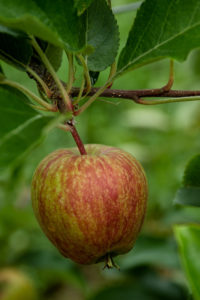 July 2, 2019
July 2, 2019
The insect pests of primary concern at this time are second generation codling moth and first generation brown marmorated stink bug (BMSB), but the need for insecticidal control is dependent on location (i.e., mountain versus piedmont locations).
Codling Moth: In higher elevation orchards such as Henderson County and other locations >2000 ft., codling moth degree day (DD) accumulations since biofix are about 1350 DD, compared to about 1720 DD in Cleveland County. The ideal timing for an insecticide against second generation codling moth in orchards NOT using mating disruption is about 1450 DD. Based on predicted temperatures, 1450 DD in Henderson County will occur on Saturday or Sunday (July 6 or 7). Hence, it would probably be wise to include an insecticide against codling moth in your next spray, especially if spraying is occurring at 14-day intervals. If an effective insecticide application against codling moth has not yet been made in lower elevation orchards, one should be made as soon as possible.
In orchards using mating disruption for codling moth, there is usually no need to apply an insecticide against the second generation. Additionally, in orchards not using mating disruption, but which have very low codling moth populations (based on low pheromone trap captures and no evidence of damage by the first generation), a codling moth insecticide can be delayed until trap captures reach 3 to 5 moths/week.
Brown Marmorated Stink Bug: The greatest threat of BMSB damage to apples is by first generation adults, which generally emerge in mid July and early August in piedmont and mountain areas, respectively. The timing of emergence can be predicted quite accurately by knowing when eggs were first laid by overwintering adults. By caging overwintering adults, we were able to detect first egg laying on May 7 in the piedmont and May 15 in Henderson County. Development from egg to adult requires 540 cumulative DD, and as of today total DD accumulations are 524 in the Piedmont (Cleveland County) and 356 in the Mountains (Henderson County). Based on temperature forecasts, 540 DD is predicted to occur on July 5 in Cleveland County and July 23 in Henderson County.
Hence, a spray for BMSB in piedmont locations should be considered later this week or next week. In the mountains, there should be no need for BMSB sprays for at least 3 weeks.
Learn more about southeastern apple insect pests at the Apple Insect Management page.
2019 Average Weekly Trap Captures
| HENDERSON COUNTY | |||
| Insects per trap | |||
| Jun 17 | Jun 24 |
July 1 |
|
| Codling Moth | 1.3 | 1.0 | 2.0 |
| Oriental Fruit Moth | 16.0 | 9.5 | 10.0 |
| Tufted Apple Bud Moth | 3.0 | 1.0 | 0.0 |
| Redbanded Leafroller | 0.0 | 0.0 | 4.0 |
| Obliquebanded Leafroller | 6.0 | 5.0 | 0.0 |
| Lesser Appleworm | 1.0 | 0.0 | 0.0 |
| Apple Maggot (abandoned and research) | 0.0 | 0.4 | 0.2 |
| Brown Marmorated Stink Bug (commercial – mountains) | 0.5 | 0.8 | 0.6 |
| Brown Marmorated Stink Bug (commercial – upper Piedmont) | 1.4 | 1.4 | 2.6 |
| Brown Marmorated Stink Bug (research – unsprayed) | 1.7 | 2.0 | 0.7 |
| Spotted Tentiform Leafminer | 0.0 | 28.0 | 18.0 |
| Dogwood Borer | 11.0 | 11.0 | 12.0 |
| Peachtree Borer | 10.0 | 17.0 | 34.0 |
| Lesser Peachtree Borer | 55.0 | 11.0 | 39.0 |
| San Jose Scale | 0.0 | 405.0 | 781.0 |
*Note that these averages illustrate only the timing of insect emergence and fluctuations in populations, and are not representative of population levels in any given orchard. The only way to have an accurate assessment of an individual orchard’s populations is to set up traps in that orchard.
2019 Accumulated Degree Days
| Henderson County | ||||
| Biofix | Jun 17 |
Jun 24 |
July 1 |
|
| Codling Moth | Apr 15 | 1020 | 1156 | 1344 |
| Oriental Fruit Moth | Mar 16 | 1590 | 1755 | 1983 |
| Tufted Apple Bud Moth | Apr 20 | 1247 | 1413 | 1641 |
June 25, 2019
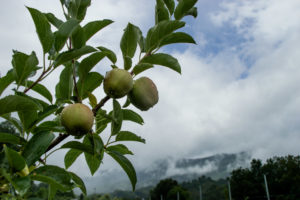 In piedmont locations (e.g., Cleveland County), codling moth DD accumulations are about 1400 as of today. This timing coincides with predicted first egg hatch of the second codling moth generation. Hence, in these lower elevation orchards an insecticide effective against codling moth is recommended at the next spray. However, if pheromone trap captures remain low during this time, this application can be delayed for another week or so.
In piedmont locations (e.g., Cleveland County), codling moth DD accumulations are about 1400 as of today. This timing coincides with predicted first egg hatch of the second codling moth generation. Hence, in these lower elevation orchards an insecticide effective against codling moth is recommended at the next spray. However, if pheromone trap captures remain low during this time, this application can be delayed for another week or so.
In Henderson County, codling moth DD accumulations average only about 1200 as of today, and it will likely be another 10 to 14 days before second generation flight is underway. In a survey of several orchards on Tuesday, fruit generally look very clean with no evidence of internal worm damage.
Brown marmorated stink bug pheromone trap captures remain steady in both the mountains and piedmont locations, averaging about 0.8 and 1.4 bugs per trap, respectively. The greatest incidence of damage is associated with first generation adults, which are expected to begin emerging in piedmont locations in about two weeks. Emergence at higher elevations (≥2000 ft) occurs about two weeks later, in late July to early August.
Learn more about southeastern apple insect pests at the Apple Insect Management page.
2019 Average Weekly Trap Captures
| HENDERSON COUNTY | |||
| Insects per trap | |||
| Jun 10 |
Jun 17 |
Jun 24 |
|
| Codling Moth | 1.3 | 1.3 | 1.0 |
| Oriental Fruit Moth | 8.8 | 16.0 | 9.5 |
| Tufted Apple Bud Moth | 3.0 | 3.0 | 1.0 |
| Redbanded Leafroller | 2.0 | 0.0 | 0.0 |
| Obliquebanded Leafroller | 18.0 | 6.0 | 5.0 |
| Lesser Appleworm | 0.0 | 1.0 | 0.0 |
| Apple Maggot (abandoned and research) | 0.0 | 0.0 | 0.4 |
| Brown Marmorated Stink Bug (commercial – mountains) | 0.4 | 0.5 | 0.8 |
| Brown Marmorated Stink Bug (commercial – upper Piedmont) | 3.1 | 1.4 | 1.4 |
| Brown Marmorated Stink Bug (research – unsprayed) | 0.5 | 1.7 | 2.0 |
| Spotted Tentiform Leafminer | 25.0 | 0.0 | 28.0 |
| Dogwood Borer | 41.0 | 11.0 | 11.0 |
| Peachtree Borer | 6.0 | 10.0 | 17.0 |
| Lesser Peachtree Borer | 40.0 | 55.0 | 11.0 |
| San Jose Scale | 0.0 | 0.0 | 405.0 |
*Note that these averages illustrate only the timing of insect emergence and fluctuations in populations, and are not representative of population levels in any given orchard. The only way to have an accurate assessment of an individual orchard’s populations is to set up traps in that orchard.
2019 Accumulated Degree Days
| Henderson County | ||||
| Biofix | Jun 10 |
Jun 17 |
Jun 24 |
|
| Codling Moth | Apr 15 | 881 | 1020 | 1156 |
| Oriental Fruit Moth | Mar 16 | 1411 | 1590 | 1755 |
| Tufted Apple Bud Moth | Apr 20 | 1069 | 1247 | 1413 |
June 18, 2019
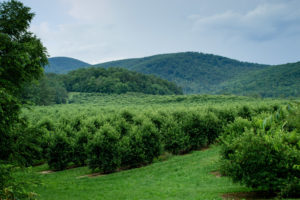 At elevations greater than 2000 ft, such as Henderson County, the insect situation has not changed from last week. We remain in that timeframe where the threat of damage by direct pests such as codling moth, OFM, apple maggot and brown marmorated stink bug are at their lowest level. This low-threat period is expected to last for another two weeks, when second generation codling moth emergence is expected to begin.
At elevations greater than 2000 ft, such as Henderson County, the insect situation has not changed from last week. We remain in that timeframe where the threat of damage by direct pests such as codling moth, OFM, apple maggot and brown marmorated stink bug are at their lowest level. This low-threat period is expected to last for another two weeks, when second generation codling moth emergence is expected to begin.
Off the mountain in lower elevation piedmont sites, codling moth degree-day accumulations are at about 1330. Depending on pheromone trap captures and occurrence of damage by first generation codling moth, an insecticide spray against the second generation is recommended between about 1450 to 1550 DD; 1450 in orchards with moderate pest density (e.g., trap captures exceed 3 to 5 moths per trap per week) and 1550 in orchards with low pest density (e.g., trap captures are less than 2 to 3 moths per week). These timings are predicted to occur later this week to early next week.
Learn more about southeastern apple insect pests at the Apple Insect Management page.
2019 Average Weekly Trap Captures
| HENDERSON COUNTY | |||
| Insects per trap | |||
| Jun 4 |
Jun 10 |
Jun 17 |
|
| Codling Moth | 1.3 | 1.3 | 1.3 |
| Oriental Fruit Moth | 14.8 | 8.8 | 16.0 |
| Tufted Apple Bud Moth | 14.0 | 3.0 | 3.0 |
| Redbanded Leafroller | 2.0 | 2.0 | 0.0 |
| Obliquebanded Leafroller | 12.0 | 18.0 | 6.0 |
| Lesser Appleworm | 0.0 | 0.0 | 1.0 |
| Apple Maggot (abandoned and research) | 0.0 | 0.0 | 0.0 |
| Brown Marmorated Stink Bug (commercial – mountains) | 1.8 | 0.4 | 0.5 |
| Brown Marmorated Stink Bug (commercial – upper Piedmont) | 4.2 | 3.1 | 1.4 |
| Brown Marmorated Stink Bug (research – unsprayed) | 0.3 | 0.5 | 1.7 |
| Spotted Tentiform Leafminer | 11.0 | 25.0 | 0.0 |
| Dogwood Borer | 46.0 | 41.0 | 11.0 |
| Peachtree Borer | 4.0 | 6.0 | 10.0 |
| Lesser Peachtree Borer | 24.0 | 40.0 | 55.0 |
| San Jose Scale | 0.0 | 0.0 | 0.0 |
*Note that these averages illustrate only the timing of insect emergence and fluctuations in populations, and are not representative of population levels in any given orchard. The only way to have an accurate assessment of an individual orchard’s populations is to set up traps in that orchard.
2019 Accumulated Degree Days
| Henderson County | ||||
| Biofix | Jun 4 | Jun 10 |
Jun 17 |
|
| Codling Moth | Apr 15 | 761 | 881 | 1020 |
| Oriental Fruit Moth | Mar 16 | 1261 | 1411 | 1590 |
| Tufted Apple Bud Moth | Apr 20 | 919 | 1069 | 1247 |
June 11, 2019
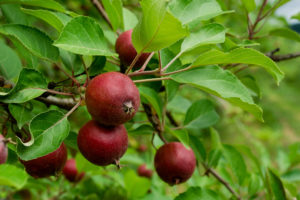 We are at the time when the threat of damage by direct insect pests is at the expected lowest point of the year. First generation codling moth is now complete, and second generation OFM populations are (as typical) very low. In Henderson County, brown marmorated stink bug pheromone trap captures have declined to less than 1 per trap. There remain some BMSB hotspots, particularly in the lower-elevation piedmont areas. BMSB populations have been considerably higher at all piedmont versus mountain trapping sites this year.
We are at the time when the threat of damage by direct insect pests is at the expected lowest point of the year. First generation codling moth is now complete, and second generation OFM populations are (as typical) very low. In Henderson County, brown marmorated stink bug pheromone trap captures have declined to less than 1 per trap. There remain some BMSB hotspots, particularly in the lower-elevation piedmont areas. BMSB populations have been considerably higher at all piedmont versus mountain trapping sites this year.
Pests that are the most likely to require insecticidal control are the same as those mentioned last week – potato leafhopper, aphids and European red mite.
Learn more about southeastern apple insect pests at the Apple Insect Management page.
2019 Average Weekly Trap Captures
| HENDERSON COUNTY | |||
| Insects per trap | |||
| May 28 |
Jun 4 |
Jun 10 |
|
| Codling Moth | 3.7 | 1.3 | 1.3 |
| Oriental Fruit Moth | 12.3 | 14.8 | 8.8 |
| Tufted Apple Bud Moth | 112.0 | 14.0 | 3.0 |
| Redbanded Leafroller | 0.0 | 2.0 | 2.0 |
| Obliquebanded Leafroller | 7.0 | 12.0 | 18.0 |
| Lesser Appleworm | 0.0 | 0.0 | 0.0 |
| Apple Maggot (abandoned and research) | – | 0.0 | 0.0 |
| Brown Marmorated Stink Bug (commercial – mountains) | 3.0 | 1.8 | 0.4 |
| Brown Marmorated Stink Bug (commercial – upper Piedmont) | 4.1 | 4.2 | 3.1 |
| Brown Marmorated Stink Bug (research – unsprayed) | 2.3 | 0.3 | 0.5 |
| Spotted Tentiform Leafminer | 44.0 | 11.0 | 25.0 |
| Dogwood Borer | 14.0 | 46.0 | 41.0 |
| Peachtree Borer | 2.0 | 4.0 | 6.0 |
| Lesser Peachtree Borer | 37.0 | 24.0 | 40.0 |
| San Jose Scale | 0.0 | 0.0 | 0.0 |
*Note that these averages illustrate only the timing of insect emergence and fluctuations in populations, and are not representative of population levels in any given orchard. The only way to have an accurate assessment of an individual orchard’s populations is to set up traps in that orchard.
2019 Accumulated Degree Days
| Henderson County | ||||
| Biofix | May 28 | Jun 4 | Jun 10 |
|
| Codling Moth | Apr 15 | 620 | 761 | 881 |
| Oriental Fruit Moth | Mar 16 | 1089 | 1261 | 1411 |
| Tufted Apple Bud Moth | Apr 20 | 747 | 919 | 1069 |
June 4, 2019
M ost areas are now at that time when the need for control of direct pests (i.e., codling moth, OFM, and TABM) is declining and greater attention should be directed to secondary pests, such as aphids, leafhoppers and mites.
ost areas are now at that time when the need for control of direct pests (i.e., codling moth, OFM, and TABM) is declining and greater attention should be directed to secondary pests, such as aphids, leafhoppers and mites.
With codling moth degree-day accumulations at 761 in Henderson County, we are on the tail end of first generation egg hatch. In lower elevations with higher temperatures DD accumulations exceed 1000, and first generation egg hatch has completed. Additional insecticide sprays for first generation codling moth are only needed in problem orchards where pheromone trap captures remain high.
In those locations where an insecticide effective against tufted apple bud moth has not been applied within the last 10 to 14 days, the window of opportunity to control this pest will disappear in about a week. TABM DD accumulations are at 919 in Henderson County.
Second generation oriental fruit moth flight is beginning or underway throughout the area, but this generation is historically very low and usually does not require insecticidal control where insecticides were targeted for this pest at petal fall, or where mating disruption is being used. However, pheromone trap captures should be the final basis of the need for control.
Brown marmorated stink bug populations have declined from an average of about 3.0 last week to 2.0 per trap this week. As the overwintered adult population declines, the threat for damage to apples is expected to be low until first generation adults emerge in four to six weeks, depending on elevation.
Apple aphids and potato leafhoppers are increasing throughout the region. Most neonicotinoid insecticides, as well as Beleaf, will provide excellent control of these pests. For those concerned about impacts on pollinators, insecticides least harmful to bees include Assail, Sivanto Prime, Versys, and Beleaf.
Finally, there are reports of European red mite populations requiring control in many orchards. Expect ERM to remain a potential threat through at least June.
Learn more about southeastern apple insect pests at the Apple Insect Management page.
2019 Average Weekly Trap Captures
| HENDERSON COUNTY | |||
| Insects per trap | |||
| May 20 |
May 28 |
Jun 4 |
|
| Codling Moth | 2.0 | 3.7 | 1.3 |
| Oriental Fruit Moth | 2.7 | 12.3 | 14.8 |
| Tufted Apple Bud Moth | 39.0 | 112.0 | 14.0 |
| Redbanded Leafroller | 0.0 | 0.0 | 2.0 |
| Obliquebanded Leafroller | 2.0 | 7.0 | 12.0 |
| Lesser Appleworm | 0.0 | 0.0 | 0.0 |
| Apple Maggot (abandoned and research) | – | – | 0.0 |
| Brown Marmorated Stink Bug (commercial – mountains) | 2.1 | 3.0 | 1.8 |
| Brown Marmorated Stink Bug (commercial – upper Piedmont) | 1.7 | 4.1 | 4.2 |
| Brown Marmorated Stink Bug (research – unsprayed) | 1.3 | 2.3 | 0.3 |
| Spotted Tentiform Leafminer | 0.0 | 44.0 | 11.0 |
| Dogwood Borer | 4.0 | 14.0 | 46.0 |
| Peachtree Borer | 0.0 | 2.0 | 4.0 |
| Lesser Peachtree Borer | 64.0 | 37.0 | 24.0 |
| San Jose Scale | 0.0 | 0.0 | 0.0 |
*Note that these averages illustrate only the timing of insect emergence and fluctuations in populations, and are not representative of population levels in any given orchard. The only way to have an accurate assessment of an individual orchard’s populations is to set up traps in that orchard.
2019 Accumulated Degree Days
| Henderson County | ||||
| Biofix | May 21 |
May 28 |
Jun 4 |
|
| Codling Moth | Apr 15 | 448 | 620 | 761 |
| Oriental Fruit Moth | Mar 16 | 882 | 1089 | 1261 |
| Tufted Apple Bud Moth | Apr 20 | 540 | 747 | 919 |
May 28, 2019
In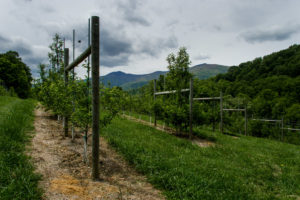 sect activity is beginning to increase with the warm, dry conditions. Insects of potential concern including codling moth, tufted apple bud moth, brown marmorated stink bug, and leafhoppers and aphids. See the table at the end of this report for insecticide recommendations for these insects.
sect activity is beginning to increase with the warm, dry conditions. Insects of potential concern including codling moth, tufted apple bud moth, brown marmorated stink bug, and leafhoppers and aphids. See the table at the end of this report for insecticide recommendations for these insects.
In the mountains at about 2100 ft elevation (i.e., Henderson County), codling moth degree day (DD) accumulations since biofix are at about 620, which coincides with almost 90% emergence of first generation codling moth adults and about 45% egg hatch. With warm temperatures in the forecast, the major part of first generation flight and egg laying should be complete in the next week or so. Off the mountain, where DD accumulations are at about 875 to 900, first generation flight is complete, and no further sprays should be necessary in most orchards; the exception being those orchards with historically high populations or where moths are continuing to be caught in significant numbers in pheromone traps.
Tufted apple bud moth DD accumulations range from about 700 in higher elevations to >900 in piedmont production areas. This is the ideal timing for an insecticide application to control this pest. In addition to insecticides recommended for codling moth (e.g., Altacor and Delegate), Intrepid is also an excellent product for TABM.
Brown marmorated stink bug pheromone trap captures continued to increase during the past week at most of our monitoring sites, increasing from an average of 2.0 last week to 3.8 this week. This trap increase represents increased activity of overwintering bugs, not first generation bugs, so a single insecticide application should be sufficient to suppress this infestation. Where codling moth and/or TABM also require control, a tank mix of two products or a premix is recommended (see table of recommendations below). It should be noted that with warm, dry conditions expected for the near future, it would be better to use a neonicotinoid rather than pyrethroid active ingredient for BMSB control at this time of the year, as the pyrethroids will likely aggravate European red mite populations.
Finally, aphids and leafhoppers are finally appearing. Insecticides recommended for BMSB will also control these insects.
| Recommendations for Control of Insect Pests of Apple | ||||
| +++ = excellent, ++ = good, + = fair, – = no activity | ||||
| Insecticide | Codling Moth | TABM | BMSB | Aphids, leafhoppers |
| Altacor | +++ | +++ | – | – |
| Delegate | +++ | +++ | – | – |
| Intrepid | ++ | +++ | – | – |
| Actara | – | – | +++ | +++ |
| Admire | – | – | + | +++ |
| Belay | – | – | +++ | +++ |
| *Pyrethroids | + | +++ | +++ | +++ |
| †Voliam Flexi | +++ | +++ | +++ | +++ |
| *†Besiege | +++ | +++ | +++ | +++ |
| *Products containing pyrethroids are likely to lead to increased problems with European red mite. | ||||
| †Voliam Flexi and Besiege are both premixes, containing two active ingredients. Voliam Flexi is a mix of chlorantraniliprole (A.I. in Altacor) plus thiamethoxam (A.I. in Actara), while Besiege is a mix of chlorantraniliprole plus lambda-cyhalothrin (A.I. in Warrior and Karate). | ||||
Learn more about southeastern apple insect pests at the Apple Insect Management page.
2019 Average Weekly Trap Captures
| HENDERSON COUNTY | |||
| Insects per trap | |||
| May 13 |
May 20 |
May 28 |
|
| Codling Moth | 1.7 | 2.0 | 3.7 |
| Oriental Fruit Moth | 6.7 | 2.7 | 12.3 |
| Tufted Apple Bud Moth | 90.0 | 39.0 | 112.0 |
| Redbanded Leafroller | 0.0 | 0.0 | 0.0 |
| Obliquebanded Leafroller | 1.0 | 2.0 | 7.0 |
| Lesser Appleworm | 0.0 | 0.0 | 0.0 |
| Apple Maggot (abandoned and research) | – | – | – |
| Brown Marmorated Stink Bug (commercial – mountains) | 0.6 | 2.1 | 3.0** |
| Brown Marmorated Stink Bug (commercial – upper Piedmont) | 1.7 | 1.7 | 4.1 |
| Brown Marmorated Stink Bug (research – unsprayed) | 0.7 | 1.3 | 2.3 |
| Spotted Tentiform Leafminer | 0.0 | 0.0 | 44.0 |
| Dogwood Borer | 7.0 | 4.0 | 14.0 |
| Peachtree Borer | 0.0 | 0.0 | 2.0 |
| Lesser Peachtree Borer | 21.0 | 64.0 | 37.0 |
| San Jose Scale | 0.0 | 0.0 | 0.0 |
*Note that these averages illustrate only the timing of insect emergence and fluctuations in populations, and are not representative of population levels in any given orchard. The only way to have an accurate assessment of an individual orchard’s populations is to set up traps in that orchard.
**Corrected from original posting.
2019 Accumulated Degree Days
| Henderson County | ||||
| Biofix | May 14 |
May 21 |
May 28 |
|
| Codling Moth | Apr 15 | 377 | 448 | 620 |
| Oriental Fruit Moth | Mar 16 | 760 | 882 | 1089 |
| Tufted Apple Bud Moth | Apr 20 | 417 | 540 | 747 |
May 21, 2019
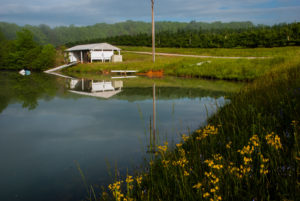 The insect situation has not appreciably changed since last week. Codling moth remains the key pest of concern throughout the region. Cumulative degree-days range from about 445 in Henderson County to about 656 in Cleveland County, which indicates we are in the midst of first generation egg laying. Overall, populations have been quite low throughout the area. With unseasonably warm weather forecast for the next few weeks, first generation flight should be completed much sooner than normal; the main period of activity should be complete in about a week in lower elevations such as Cleveland County, and about two weeks in Henderson County.
The insect situation has not appreciably changed since last week. Codling moth remains the key pest of concern throughout the region. Cumulative degree-days range from about 445 in Henderson County to about 656 in Cleveland County, which indicates we are in the midst of first generation egg laying. Overall, populations have been quite low throughout the area. With unseasonably warm weather forecast for the next few weeks, first generation flight should be completed much sooner than normal; the main period of activity should be complete in about a week in lower elevations such as Cleveland County, and about two weeks in Henderson County.
The warm spring has also accelerated tufted apple bud moth development, with about 550 DD accumulated since biofix in Henderson County. A single insecticide spray made between about 700 and 1200 DD will provide season-long control of TABM. Insecticides of choice include Altacor, Delegate, and Intrepid, all of which are highly effective against this pest.
Brown marmorated stink bug pheromone trap captures increased this week across the area, increasing from an average of 0.7 last week to 2.0 this week. Whether this increase justifies an insecticide application is debatable. We are currently testing a preliminary threshold level of 4 cumulative bugs per trap, and based on averages across all orchards we are currently at about 3, so from this perspective one may want to wait until next week to see if numbers still increase. The need for BMSB control in orchards this early in the season is unusual. Last year at this time trap captures were slightly higher than now, and damage was minimal despite few insecticide sprays being made.
The anticipated stretch of hot dry weather should make conditions ideal for European red mite outbreaks, so it would be wise to begin scouting at this time. Surprisingly there have been very few aphids or leafhoppers observed to date. However, it is usually late May to early June when these insects appear, so anticipate these pests in the next two weeks.
Learn more about southeastern apple insect pests at the Apple Insect Management page.
2019 Average Weekly Trap Captures
| HENDERSON COUNTY | |||
| Insects per trap | |||
| May 6 |
May 13 |
May 20 |
|
| Codling Moth | 4.0 | 1.7 | 2.0 |
| Oriental Fruit Moth | 26.3 | 6.7 | 2.7 |
| Tufted Apple Bud Moth | 37.0 | 90.0 | 39.0 |
| Redbanded Leafroller | 0.0 | 0.0 | 0.0 |
| Obliquebanded Leafroller | 0.0 | 1.0 | 2.0 |
| Lesser Appleworm | 0.0 | 0.0 | 0.0 |
| Apple Maggot (abandoned and research) | – | – | – |
| Brown Marmorated Stink Bug (commercial – mountains) | 1.0 | 0.6 | 2.1 |
| Brown Marmorated Stink Bug (commercial – upper Piedmont) | 3.3 | 1.7 | 1.7 |
| Brown Marmorated Stink Bug (research – unsprayed) | 0.5 | 0.7 | 1.3 |
| Spotted Tentiform Leafminer | 0.0 | 0.0 | 0.0 |
| Dogwood Borer | 0.0 | 7.0 | 4.0 |
| Peachtree Borer | 0.0 | 0.0 | 0.0 |
| Lesser Peachtree Borer | 112.0 | 21.0 | 64.0 |
| San Jose Scale | 2.5 | 0.0 | 0.0 |
*Note that these averages illustrate only the timing of insect emergence and fluctuations in populations, and are not representative of population levels in any given orchard. The only way to have an accurate assessment of an individual orchard’s populations is to set up traps in that orchard.
2019 Accumulated Degree Days
| Henderson County | ||||
| Biofix | May 7 |
May 14 |
May 21 |
|
| Codling Moth | Apr 15 | 260 | 377 | 448 |
| Oriental Fruit Moth | Mar 16 | 632 | 760 | 882 |
| Tufted Apple Bud Moth | Apr 20 | 290 | 417 | 540 |
May 14, 2019
Codling Moth: We remain in the timeframe when codling moth is the key insect of concern in apples. Degree-day accumulations since biofix range from about 360 in Henderson County (2100 ft elevation) to about 550 in Cleveland County (850 ft). First generation codling moth can remain active through about 600 to 800 DD, depending on population density. Generally, the higher the population the later activity declines.
In locations of about 2000 ft elevation, 350 DD coincides with the optimum timing for the first of either one or two applications against the first generation. A second application is recommended in another two to three weeks, at which time a spray for tufted apple bud moth is also recommended.
In lower elevations, where DD accumulations average about 550, a final spray for first generation codling moth in orchards with low to moderate populations is recommended at this time. This will also coincide with tufted apple bud moth (TABM) in these locations.
It should be noted that the above are general recommendations for orchards that are not using mating disruption. The number of sprays required will vary depending on the intensity of populations, and the only way to know population intensity is with the use of pheromone traps (See the article from April 10 on pheromone trapping). In some instances only one insecticide spray will be necessary, while in orchards with high populations as many as 3 or 4 applications may be necessary.
As in past years, Altacor and Delegate remain the most effective insecticides against codling moth, and whichever product is used against the first generation should NOT be used against the second generation in July – it is necessary to alternate insecticides against generations. Also, for those orchards with very low codling moth populations and where only one application may be necessary, you may want to consider Intrepid for a second application where TABM control is also necessary, Intrepid is an excellent product for control of TABM, but should not be relied upon for control of moderate to high codling moth populations.
Brown Marmorated Stink Bug: Much of the BMSB population has emerged from overwintering sites, and emergence is expected to be complete in the next week or two. To date populations have been relatively low, averaging less than one per trap across the region. Beginning next week we will provide degree-day accumulations for BMSB and estimates of when first generation adult emergence is expected. While things can always change, at this time we do not expect action will be necessary against this pest until July (Piedmont) or August (mountains).
Learn more about southeastern apple insect pests at the Apple Insect Management page.
2019 Average Weekly Trap Captures
| HENDERSON COUNTY | |||
| Insects per trap | |||
| Apr 29 |
May 6 |
May 13 |
|
| Codling Moth | 4.5 | 4.0 | 1.7 |
| Oriental Fruit Moth | 67.5 | 26.3 | 6.7 |
| Tufted Apple Bud Moth | 15.0 | 37.0 | 90.0 |
| Redbanded Leafroller | 1.0 | 0.0 | 0.0 |
| Obliquebanded Leafroller | – | 0.0 | 1.0 |
| Lesser Appleworm | – | 0.0 | 0.0 |
| Apple Maggot (abandoned and research) | – | – | – |
| Brown Marmorated Stink Bug (commercial – mountains) | 1.4 | 1.0 | 0.6 |
| Brown Marmorated Stink Bug (commercial – upper Piedmont) | 3.7 | 3.3 | 1.7 |
| Brown Marmorated Stink Bug (research – unsprayed) | 1.0 | 0.5 | 0.7 |
| Spotted Tentiform Leafminer | 0.0 | 0.0 | 0.0 |
| Dogwood Borer | – | 0.0 | 7.0 |
| Peachtree Borer | 0.0 | 0.0 | 0.0 |
| Lesser Peachtree Borer | 58.0 | 112.0 | 21.0 |
| San Jose Scale | 0.0 | 2.5 | 0.0 |
*Note that these averages illustrate only the timing of insect emergence and fluctuations in populations, and are not representative of population levels in any given orchard. The only way to have an accurate assessment of an individual orchard’s populations is to set up traps in that orchard.
2019 Accumulated Degree Days
| Henderson County | ||||
| Biofix | Apr 29 |
May 7 |
May 14 |
|
| Codling Moth | Apr 15 | 133 | 260 | 377 |
| Oriental Fruit Moth | Mar 16 | 466 | 632 | 760 |
| Tufted Apple Bud Moth | Apr 20 | 124 | 290 | 417 |
May 7, 2019
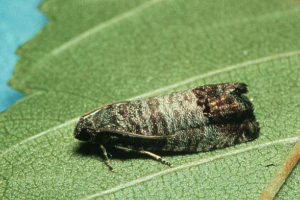 Codling Moth: The major insect of concern at this time is the codling moth. Degree-day accumulation in the mountains at about 2100 ft elevation was 260 as of May 6, and in the piedmont at an elevation of 900 ft, it was 400.
Codling Moth: The major insect of concern at this time is the codling moth. Degree-day accumulation in the mountains at about 2100 ft elevation was 260 as of May 6, and in the piedmont at an elevation of 900 ft, it was 400.
In orchards with moderate to high populations of codling moth, first generation egg hatch begins at about 250 DD, so in those orchards an insecticide effective against codling moth should already have been made. In orchards with low populations – i.e., none or very low damage last year and no more than about 2 moths captured in pheromone traps during the past week – waiting until about 350 DD for an initial application is most efficient. In the mountains this is predicted to occur early next week, and in piedmont orchards we are beyond that point.
Remember, the above predictions are for orchards NOT using mating disruption. Where mating disruption is being used for codling moth and OFM, an insecticide is not recommended until tufted apple bud moth cumulative degree days reach 600 to 800.
European Red Mite Sighting: There have been reports of European red mite showing up on apples this week in Henderson County. In the past 20 years, this is only the second time I am aware of ERM appearing this early in the season. This is unusually early, and probably reflects the more widespread use of pyrethroids in recent years. Hence, in those orchards that did not use a preventive miticide application (e.g., Agri-Mek, Zeal, Apollo, Savey or Envidor), it would be wise to check your most mite-susceptible blocks.
Learn more about southeastern apple insect pests at the Apple Insect Management page.
2019 Average Weekly Trap Captures
| HENDERSON COUNTY | |||
| Insects per trap | |||
| Apr 22 |
Apr 29 |
May 6 |
|
| Codling Moth | 4.0 | 4.5 | 4.0 |
| Oriental Fruit Moth | 61.0 | 67.5 | 26.3 |
| Tufted Apple Bud Moth | 3.0 | 15.0 | 37.0 |
| Redbanded Leafroller | 0.0 | 1.0 | 0.0 |
| Obliquebanded Leafroller | – | – | 0.0 |
| Lesser Appleworm | – | – | 0.0 |
| Apple Maggot (abandoned and research) | – | – | – |
| Brown Marmorated Stink Bug (commercial – mountains) | – | 1.4 | 1.0 |
| Brown Marmorated Stink Bug (commercial – upper Piedmont) | – | 3.7 | 3.3 |
| Brown Marmorated Stink Bug (research – unsprayed) | 0.0 | 1.0 | 0.5 |
| Spotted Tentiform Leafminer | 0.0 | 0.0 | 0.0 |
| Dogwood Borer | – | – | 0.0 |
| Peachtree Borer | 0.0 | 0.0 | 0.0 |
| Lesser Peachtree Borer | 5.0 | 58.0 | 112.0 |
| San Jose Scale | 0.0 | 0.0 | 2.5 |
*Note that these averages illustrate only the timing of insect emergence and fluctuations in populations, and are not representative of population levels in any given orchard. The only way to have an accurate assessment of an individual orchard’s populations is to set up traps in that orchard.
2019 Accumulated Degree Days
| Henderson County | ||||
| Biofix | Apr 22 |
Apr 30 |
May 7 |
|
| Codling Moth | Apr 15 | 45 | 133 | 260 |
| Oriental Fruit Moth | Mar 16 | 348 | 466 | 632 |
| Tufted Apple Bud Moth | Apr 20 | 18 | 124 | 290 |
April 30, 2019
By now petal fall applications have been made in most locations except for the highest elevation orchards (e.g., ≥3000 feet), and attention can now move to other pests – especially the codling moth.
Codling Moth: Codling moth biofix date in Henderson County (elevation about 2100 ft) occurred on 15 April. Typically biofix occurs about a week earlier off the mountain in Cleveland and Lincoln Counties (about 900ft), and is estimated to have occurred on 8 April. Codling moth egg hatch begins at about 250 cumulative degree days (DD), which is the recommended timing of first insecticide applications in orchards with moderate to high populations. For orchards with low populations, which is the more common situation, the initial timing can be delayed to about 350 DD.
In Henderson County we are currently at about 133 DD, and 250 DD is estimated to occur next Monday (May 6) and 350 DD on May 11. Off the mountain at an elevation of about 900 ft (Cleveland/Lincoln County), we are currently at about 300 DD and 350 is predicted for later this week on Friday or Saturday (May 3 or 4).
In orchards using mating disruption and where pheromone trap captures remain low, insecticides for codling moth are not necessary at this time. In most situations with mating disruption a single insecticide application against the first generation codling moth is not recommended until about 600-700 DD have accumulated, which coincides with the optimum timing of first generation tufted apple bud moth (TABM).
Regarding insecticides recommended for codling moth, they remain Altacor (3 oz/A) and Delegate (6 oz/A). One product should be used for all first-generation applications, and the other product against the second generation in July.
San Jose Scale: For those that are concerned about San Jose scale and have not yet applied an insecticide effective against this pest, anytime within the next two weeks is ideal timing for application of either Esteem or Centaur, both of which provide excellent control when used at this time.
Another option is use of Movento, which can also provide suppression of woolly apple aphid (WAA) later in the season. The systemic activity of Movento, which is unique in that it moves in both directions in the tree (leaf to leaf, and leaf to roots), is key to preventive control of WAA. It should be noted, however, that WAA is a sporadic pest and often does not develop to pest status. If using Movento, it is important to read the label to ensure proper use. It must be used with an adjuvant with spreading and penetrating properties to maximize leaf uptake for systemic activity. However, DO NOT use Induce, due to compatibility issues.
Learn more about southeastern apple insect pests at the Apple Insect Management page.
2019 Average Weekly Trap Captures
| HENDERSON COUNTY | |||
| Insects per trap | |||
| Apr 15 |
Apr 22 |
Apr 29 |
|
| Codling Moth | 1.5 | 4.0 | 4.5 |
| Oriental Fruit Moth | 101.5 | 61.0 | 67.5 |
| Tufted Apple Bud Moth | – | 3.0 | 15.0 |
| Redbanded Leafroller | 0.0 | 0.0 | 1.0 |
| Obliquebanded Leafroller | – | – | – |
| Lesser Appleworm | – | – | – |
| Apple Maggot (abandoned and research) | – | – | – |
| Brown Marmorated Stink Bug (commercial – mountains) | – | – | 1.4 |
| Brown Marmorated Stink Bug (commercial – upper Piedmont) | – | – | 3.7 |
| Brown Marmorated Stink Bug (research – unsprayed) | 0.2 | 0.0 | 1.0 |
| Spotted Tentiform Leafminer | n/a | 0.0 | 0.0 |
| Dogwood Borer | – | – | – |
| Peachtree Borer | – | 0.0 | 0.0 |
| Lesser Peachtree Borer | – | 5.0 | 58.0 |
| San Jose Scale | 0.0 | 0.0 | 0.0 |
*Note that these averages illustrate only the timing of insect emergence and fluctuations in populations, and are not representative of population levels in any given orchard. The only way to have an accurate assessment of an individual orchard’s populations is to set up traps in that orchard.
2019 Accumulated Degree Days
| Henderson County | ||||
| Biofix | Apr 15 |
Apr 22 |
Apr 30 |
|
| Codling Moth | Apr 15 | – | 45 | 133 |
| Oriental Fruit Moth | Mar 16 | 282 | 348 | 466 |
| Tufted Apple Bud Moth | Apr 20 | – | 18 | 124 |
April 23, 2019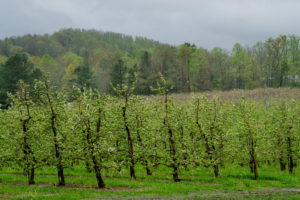
Learn more about southeastern apple insect pests at the Apple Insect Management page.
2019 Average Weekly Trap Captures
| HENDERSON COUNTY | |||
| Insects per trap | |||
| Apr 8 | Apr 15 |
Apr 22 |
|
| Codling Moth | 0.0 | 1.5 | 4.0 |
| Oriental Fruit Moth | 55.0 | 101.5 | 61.0 |
| Tufted Apple Bud Moth | – | – | 3.0 |
| Redbanded Leafroller | 7.0 | 0.0 | 0.0 |
| Obliquebanded Leafroller | – | – | – |
| Lesser Appleworm | – | – | – |
| Apple Maggot (abandoned and research) | – | – | – |
| Brown Marmorated Stink Bug (commercial – mountains) | – | – | – |
| Brown Marmorated Stink Bug (commercial – upper Piedmont) | – | – | – |
| Brown Marmorated Stink Bug (research – unsprayed) | – | 0.2 | 0.0 |
| Spotted Tentiform Leafminer | 3.0 | n/a | 0.0 |
| Dogwood Borer | – | – | – |
| Peachtree Borer | – | – | 0.0 |
| Lesser Peachtree Borer | – | – | 5.0 |
| San Jose Scale | 0.0 | 0.0 | 0.0 |
*Note that these averages illustrate only the timing of insect emergence and fluctuations in populations, and are not representative of population levels in any given orchard. The only way to have an accurate assessment of an individual orchard’s populations is to set up traps in that orchard.
2019 Accumulated Degree Days
| Henderson County | ||||
| Biofix | Apr 7 |
Apr 15 |
Apr 23 |
|
| Codling Moth | Apr 15 | – | – | 45 |
| Oriental Fruit Moth | Mar 16 | 151 | 282 | 348 |
| Tufted Apple Bud Moth | – | – | – | – |
April 16, 2019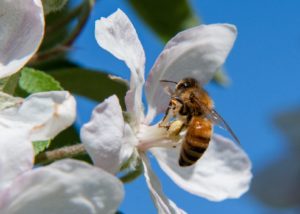
Learn more about southeastern apple insect pests at the Apple Insect Management page.
2019 Average Weekly Trap Captures
| HENDERSON COUNTY | |||
| Insects per trap | |||
| Apr 1 | Apr 8 |
Apr 15 |
|
| Codling Moth | 0.0 | 0.0 | 1.5 |
| Oriental Fruit Moth | 1.0 | 55.0 | 101.5 |
| Tufted Apple Bud Moth | – | – | – |
| Redbanded Leafroller | 17.0 | 7.0 | 0.0 |
| Obliquebanded Leafroller | – | – | – |
| Lesser Appleworm | – | – | – |
| Apple Maggot (abandoned and research) | – | – | – |
| Brown Marmorated Stink Bug (commercial – mountains) | – | – | – |
| Brown Marmorated Stink Bug (commercial – upper Piedmont) | – | – | – |
| Brown Marmorated Stink Bug (research – unsprayed) | – | – | 0.2 |
| Spotted Tentiform Leafminer | 2.0 | 3.0 | n/a |
| Dogwood Borer | – | – | – |
| Peachtree Borer | – | – | – |
| Lesser Peachtree Borer | – | – | – |
| San Jose Scale | 0.0 | 0.0 | 0.0 |
*Note that these averages illustrate only the timing of insect emergence and fluctuations in populations, and are not representative of population levels in any given orchard. The only way to have an accurate assessment of an individual orchard’s populations is to set up traps in that orchard.
2019 Accumulated Degree Days
| Henderson County | ||||
| Biofix | Apr 1 |
Apr 7 |
Apr 15 |
|
| Codling Moth | – | – | – | – |
| Oriental Fruit Moth | Mar 16 | 87 | 151 | 281.5 |
| Tufted Apple Bud Moth | – | – | – | – |
April 8, 2019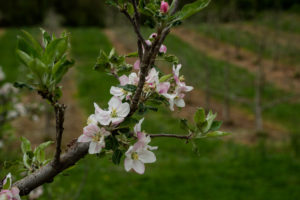
Learn more about southeastern apple insect pests at the Apple Insect Management page.
2019 Average Weekly Trap Captures
| HENDERSON COUNTY | |||
| Insects per trap | |||
| Mar 25 | Apr 1 | Apr 8 |
|
| Codling Moth | set | 0.0 | 0.0 |
| Oriental Fruit Moth | 1.0 | 1.0 | 55.0 |
| Tufted Apple Bud Moth | – | – | – |
| Redbanded Leafroller | 14.0 | 17.0 | 7.0 |
| Obliquebanded Leafroller | – | – | – |
| Lesser Appleworm | – | – | – |
| Apple Maggot (abandoned and research) | – | – | – |
| Brown Marmorated Stink Bug (commercial – mountains) | – | – | – |
| Brown Marmorated Stink Bug (commercial – upper Piedmont) | – | – | – |
| Brown Marmorated Stink Bug (research – unsprayed) | – | – | |
| Spotted Tentiform Leafminer | 0.0 | 2.0 | 3.0 |
| Dogwood Borer | – | – | |
| Peachtree Borer | – | – | |
| Lesser Peachtree Borer | – | – | |
| San Jose Scale | 0.0 | 0.0 | 0.0 |
*Note that these averages illustrate only the timing of insect emergence and fluctuations in populations, and are not representative of population levels in any given orchard. The only way to have an accurate assessment of an individual orchard’s populations is to set up traps in that orchard.
2019 Accumulated Degree Days
| Henderson County | ||||
| Biofix | Mar 25 | Apr 1 | Apr 7 |
|
| Codling Moth | – | – | – | – |
| Oriental Fruit Moth | Mar 16 | 41 | 87 | 151 |
| Tufted Apple Bud Moth | – | – | – | – |



